#1 - REDUCE LOADS / DEMAND FIRST - Passive Cooling
WHAT IS PASSIVE DESIGN?
Passive Design:
- is based upon climate considerations
- attempts to control comfort (heating and cooling) without consuming fuels
- uses the orientation of the building to control heat gain and heat loss
- uses the shape of the building (plan, section) to control air flow
- uses materials to control heat
- maximizes use of free solar energy for heating and lighting
- maximizes use of free ventilation for cooling
- uses shade (natural or architectural) to control heat gain
Passive solar heating and passive ventilation for cooling assist in creating sustainable building by reducing dependency on fossil fuels for heating and cooling buildings, as well as reducing the need for electricity to support lighting by using practices of daylighting in buildings. Passive strategies are separated for the heating and cooling systems, and work with conduction, convection, radiation and evaporation. They also look to the environment to source or sink heat.
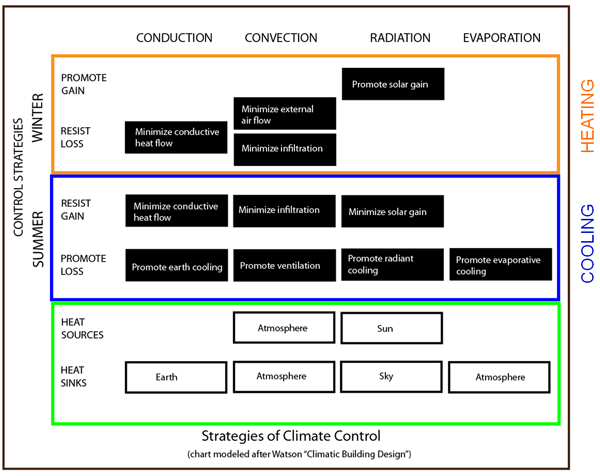
Unlike most contemporarily designed buildings that rely on “Thermostat” control to regulate the temperature and relative humidity (comfort) in buildings, Passive Buildings require occupant involvement to ensure their success. As it is likely not possible with a totally passively ventilated building to maintain a tight set point for thermal comfort, a wider range of temperature must be found to be acceptable. Sometimes Passive Buildings, due to limitations in achieving an interior climate that falls in the middle of the “comfort zone”, will require occupants to accept a wider range of acceptable temperature and relative humidity values. Passively cooled buildings might also require lifestyle changes. In countries where hot arid or hot humid climate is both extreme and the norm, lifestyles have evolved, along with indigenous and vernacular architectural types, that allow for life to slow its pace during the heat of the day. Activities may sometimes move from the interior to a cooler exterior or transitional space. These sorts of programmatic changes might need to be worked into the planning of the building.
Occupants need to be EDUCATED as to when to open and close windows, raise and lower shades, and otherwise control some of the non automated means of controlling the effects of the sun and wind on the interior environments of the building.
The most significant gains for a Carbon Neutral target will be in determining whether the building can completely forego traditional Air Conditioning. If not completely, then can some means be used to decrease the load on the system through a more natural pre-cooling of the incoming air.
THE TIERED APPROACH TO PASSIVE COOLING:
A tiered approach to passive cooling is necessary to priorize the notion of impact reduction and therefore make it more feasible to handle the cooling that cannot be met passively with renewables. The first line of defense is heat avoidance. This is partially achieved through shading and ensuring that unwanted solar gain does not enter the building.

The Tiered Approach to Passive COOLING (after Lechner)
Following heat avoidance we use passive cooling. It is important to recognize that passive cooling is much more dependent on the nuances of climate than passive heating. It is physically simpler to obtain heat from sun to increase the temperature and comfort of interior space, than it is to reduce the temperature and relative humidity of spaces passively. In many instances the reality of passive cooling is not as much an ACTUAL reduction in the dry bulb temperature as the SENSATION of coolness that is achieved through air movement or the addition or subtraction of moisture from the air.
Since the goal is to create thermal comfort during the summer (or the over-heated period), we can either:
-
cool the building by removing heat from the building by finding a heat sink
- raise the comfort zone sufficiently to include the high indoor temperature by increasing the air velocity so that the comfort zone shifts to higher temperatures
Overall passive cooling relies on two primary strategies:
1. First and foremost, prevent heat from getting into the building! If it does not come in, we don’t need to get rid of it and the problem is halfway to being solved.
- keep openings small (hot arid only), or
- use shading devices to shade larger openings (cold, hot humid, temperate)
- use vegetation for shade on the exterior of the building
- create a cool microclimate to discourage heat buildup through material choice
- situate buildings in clusters so that they shade each other as well as the interstitial spaces in between
2.
Get rid of unwanted heat that comes into the building
- in cold, temperate and even hot humid climates, mainly via ventilation
- in hot arid climates, through the diurnal cycle and the use of mass as a sink or transitional material
Passive cooling is the counterpart of passive heating. While passive heating is driven only by the sun, passive cooling can use various heat sinks and climate influences to decrease heat.
1. Ventilative Cooling: Natural ventilation results from pressure differences at the inlets and outlets of a building envelope as a result of wind velocity. Proper orientation of the openings to take advantage of the local wind patterns is essential. Inlets and outlets should be position to provide for cross ventilation, preferring more open plans.
2. Radiative Cooling: In this type of cooling, the unwanted heat is transfered to a cooler "sink". This can be achieved by radiating the heat to the cooler night sky.
3. Evaporative Cooling: Sensible heat in the air stream is exchanged for the latent heat in water droplets or wetted surfaces. The moisture evaporates, extracting the heat from the warm air, lowering its temperature. This method is only useful in dry climates and would be detrimental in humid climates as it would increase the humidity levels making them even less comfortable. The benefits of evaporative cooling need to be weighed against the environmental cost of providing water to this application.
4. Dehumidification: In a cooling system the humidity is reduced by cooling the air below dew point. A part of the moisture in the air is condensed and drained out. In hot humid environments this is the most effective way to increase the comfort level, but also one of the more difficult to achieve naturally.
5. Mass Effect Cooling: In this type of cooling, the unwanted heat is transfered to a cooler "sink". This can be achieved by earth berming the building or providing thermal mass in which to sink the heat (this could be the same thermal mass used to store heat in passive solar heating). Often this type of mass is subjected to night flushing ventilation which will direct the cool outside air over the heated mass, removing the heat from the interior of the building.
COOLING FOR HOT ARID CLIMATES:
The passive cooling strategies for hot and dry climates are very different from those for hot and humid climates. In hot arid climates shade in and of itself provides relief from the heat. Preventing the solar radiation from heating up the surrounding environment through shading ensures that the temperature of the surroundings is not increased by heat absorption. This is of particular significance in arid climates where much of the landscape is comprised of sand and stone (thermal mass), and devoid of vegetation that could be used for shade or cooling on the exterior of the building, or to create a significantly cooler microclimate around the building.
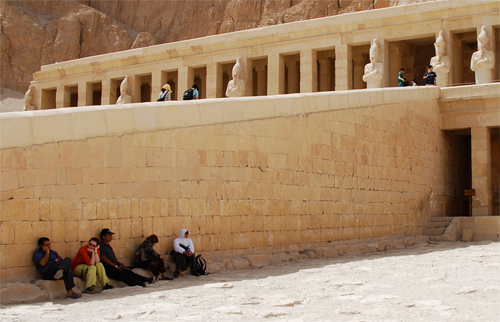
Sitting in the Shade in the Valley of the Kings
Hot arid construction uses the diurnal cycle (day to night) to manage the temperature in the building. As temperature naturally flows from hot to cold, and the desert climate tends to cool off significantly in the night hours, these buildings typically use thick mass walls (concrete, brick, adobe or rammed earth) to allow for a natural flow of temperature. Usually this means that no insulation is used in the wall assembly as the intention in a naturally cooled building is to allow for the uninterrupted flow of heat through the massive walls. Walls are often 12 inches thick as the rate of heat flow is approximately 1 inch per hour, so 12 inches works well as a rule of thumb thickness when looking at 2 cycles in 24 hours.
Hot arid construction makes heat avoidance a priority. Ventilation is not encouraged as the exterior air is normally significantly hotter than the interior air, so there is only detriment in forcing an exchange. Windows are small to keep direct sunlight entry to a minimum. Colors are light to minimize heat absorption as well as to reflect light and assist with daylighting of both the interior spaces as well as keeping a level of brightness to the surrounding neighbourhood.
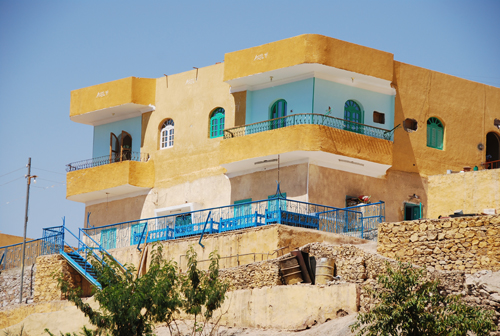
Typical Hot Arid Housing: light exterior and small windows. Shaded balconies.
Interior courtyards, if sized to provide significant self shading, can also be used to complement the program of building spaces by providing an alternate to the darker more confined interior spaces. Water features can be used in courtyards, in conjunction with plantings, to bring down the temperature of the environment.
COOLING FOR HOT HUMID CLIMATES:
Hot humid climats are characterized by those whose cooling degree days greatly exceed their heating degree days. If using the Fahrenheit scale, the relative humidity and the exterior temperature are often close to the same number! Hot humid climates provide a challenge in reaching reasonable comfort levels for the occupants using solely passive means. In hot humid climates not only must an attempt be made to lower the temperature, but removing humidity from the air. As most hot humid environments have minimal temperature differential from day to night, there is little point in the use of extensive thermal mass. Instead, a preference is given for lightweight materials that will not hold the heat.
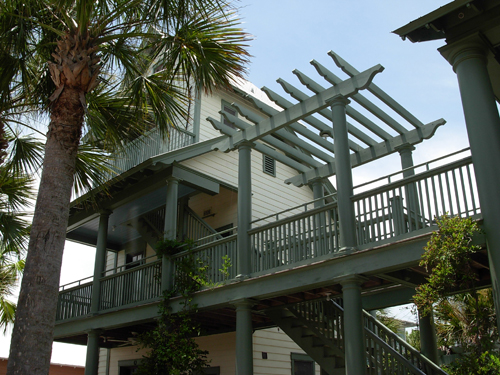
House in Seaside, Florida:
Uses lightweight materials, trellises, large porches and overhangs.
Shade is the best means for heat avoidance. Indigenous and vernacular types will employ large roof overhangs so that windows and walls can be shaded from the sun. Roofing materials may be reflective or light, again to avoid absorbing solar radiation. To increase the comfort levels in the interior, it is essential to maximize operable window openings to encourage ventilation. These openings should be able to be open during times of rain, and are often provided with venting security screens so that ventilation can continued when the space is unoccupied. If openings need to be closed during short periods of unoccupied times, heat will begin to build up. Ceiling fans are useful for moving stratified air. Air movement can also encourage evaporative cooling of the occupant's skin. It is important to remember that fans do not actually lower the temperature of the room, so need not be left running (and using electricity) when spaces are unoccupied, if there is no temperature differential in the air that is being moved.
Building section (height) is often used to enhance stack effect and naturally exhaust hot air from the upper levels of the space, while simultaneously drawing cooler air in from the lower levels. It is imperative that materials are selected that encourage a cool microclimate around the building so that air drawn in from outside is not unnecessarily heated. In some instances buildings may be elevated off of the ground so that cool air can be drawn in from beneath the building as well.
Open plans also encourage uninterrupted air flow through the space.
COOLING FOR TEMPERATE CLIMATES:
Temperate climates are characterized by locations whose heating and cooling degree days are close to being equal. Therefore passive heating and passive cooling are given equal priority in the design of the building. These sorts of buildings may be the most likely candidates for Carbon Neutral Design as their climates are not severe, making it more likely to be able to heat and cool the buildings predominantly via passive means.
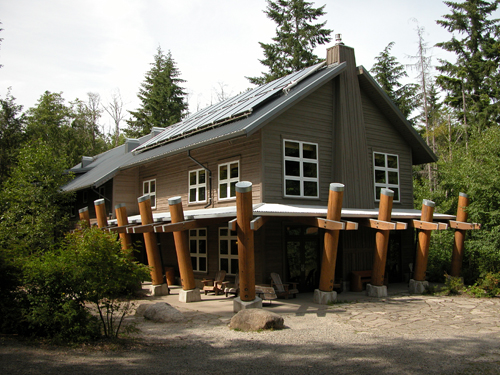
Residential Building at IslandWood on Bainbridge, Island, Washington:
The building uses orientation, microclimate and large overhangs to shade the
ample windows for ventilation cooling
The building envelope in this type should be well insulated to prevent winter heat losses, but have large openings to allow for ventilation strategies similar to hot humid buildings. Summer heat avoidance is also critical, so windows should be fitted with good shading devices, the microclimate kept cool, and thermal mass be provided on the interior of the building to provide a heat sink as this climate tends to experience some night time cooling.
COOLING FOR COLD CLIMATES:
Cold climates present designers with the problem of properly balancing the prioritization of the design to achieve successful passive solar heating, with strategies for passive cooling. If the number of heating degree days greatly exceeds the cooling degree days, then logically decisions in the design of the building, orientation and envelope should favor passive heating. Fortunately solar geometry, combined with the use of shading devices will allow for the employment of large glazed areas that will allow for successful heating strategies, and shading devices that will successfully block the sun from entering the building when cooling becomes a priority. This successfully engages the first priority of heat avoidance. As many cool to cold climates normally have some moderate to high humidity issues in the cooling season, it will become important to ensure that windows are operable and of a type to achieve a high degree of natural ventilation.
As many cold climate locations also have issues with insects (mosquitoes, West Nile Virus...) it should be noted that insect screens can cut down the effectiveness of the window opening for ventilation by approximately 50%. Operable windows should also be designed to allow for cover during periods of summer rain. Much cooling is to be gained very naturally during rain storms, but cannot occur if windows must be closed to prevent rain penetration. If roof overhangs have been designed to also shade the windows, they can provide some protection from the rain. Separate shading devices can also be designed for this purpose (if they are of the solid type). Although operable windows are more expensive than fixed panes, it may be helpful to include in the cost comparison the savings in the cost of HVAC equipment and operating costs - particularly if the system can be eliminated in its entirety.
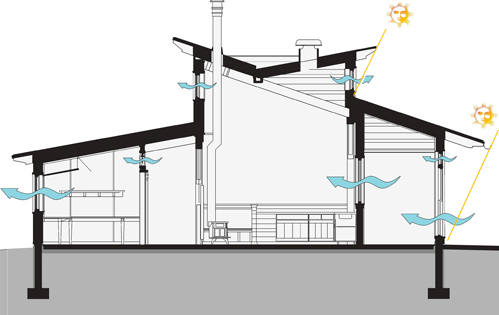
Cross Section of the Aldo Leopold Legacy Center Showing the Natural Ventilation Strategy
(notice that the length of the overhangs provides shading for the ventilating window openings,
as well as potential rain protection.
Residential buildings and smaller education buildings in cold climates are the most likely building type to be able to completely avoid mechanical cooling.
The texts noted at the bottom of this page are an excellent source of further design information on this topic, including recommendations for the sizing and placement of windows to provide the most effective ventilation strategies.

HELPFUL LINKS IN THE AIA 50to50 WIKI:
Cool Roofs
Earth Sheltering
Mass Absorption
Natural Ventilation
Sun Shading
Vegetation for Sun Control
HIGHLY RECOMMENDED TEXTS FOR PASSIVE DESIGN (written by SBSE members!):
Heating, Cooling, Lighting: Sustainable Design Methods for Architects. Third Edition. Norbert Lechner.
Mechanical and Electrical Equipment for Buildings. Benjamin Stein, John Reynolds, Walter Grondzik, Alison Kwok.
Sun, Wind and Light: Architectural Design Strategies. Second Edition. G. Z. Brown and Mark DeKay.
The Green Studio Handbook: Environmental Strategies for Schematic Design. Walter Grondzik and Alison Kwok.
|

